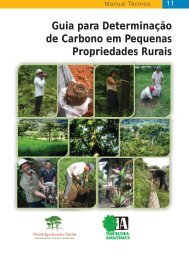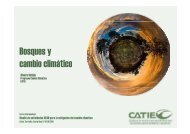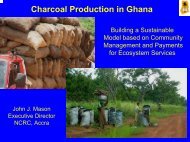Guide on Climate Change and Indigenous Peoples
Guide on Climate Change and Indigenous Peoples
Guide on Climate Change and Indigenous Peoples
- No tags were found...
You also want an ePaper? Increase the reach of your titles
YUMPU automatically turns print PDFs into web optimized ePapers that Google loves.
generati<strong>on</strong>s of humankind <strong>on</strong> the basis of equity <strong>and</strong> in accordancewith their comm<strong>on</strong> but differentiated resp<strong>on</strong>sibilities <strong>and</strong> respectivecapacities. Accordingly, the Parties of developed countries should takethe lead in combating climate change <strong>and</strong> the adverse effects thereof.• The c<strong>on</strong>tributi<strong>on</strong> of countries to climate change <strong>and</strong> their capacity toprevent <strong>and</strong> cope with its c<strong>on</strong>sequences vary significantly. The UNFCCCtherefore calls for financial assistance from countries with moreresources to those less endowed <strong>and</strong> more vulnerable.• The UNFCCC assigned operati<strong>on</strong> of the financial mechanism to theGlobal Envir<strong>on</strong>ment Facility. The financial mechanism is accountableto the COP, which decides <strong>on</strong> its climate change policies, programmepriorities, <strong>and</strong> eligibility criteria for funding.3What are the Market-based Mechanismsfor Mitigating <strong>Climate</strong> <strong>Change</strong> accordingto the Kyoto Protocol?*• These market-based mitigati<strong>on</strong> mechanisms agreed up<strong>on</strong> in theKyoto Protocal which will be implemented by Annex 1 (A1) Parties(industrialized countries) include the Clean Development Mechanism(CDM), Emissi<strong>on</strong>s Trading (ET) <strong>and</strong> Joint Implementati<strong>on</strong> (JI).• These market mechanisms seek to lower the costs of achievingemissi<strong>on</strong>s targets. The CDM allows A1 Parties to invest in projectsin n<strong>on</strong>-Annex I Parties that reduce emissi<strong>on</strong>s or that enhance sinksthrough afforestati<strong>on</strong> or reforestati<strong>on</strong>. The A1 Party can then usecredits generated by these projects toward meeting its emissi<strong>on</strong> target.Similarly, through JI, A1 Parties can receive credit for investing in projectsin other A1 Parties. Finally, emissi<strong>on</strong> trading allows A1 Parties to tradecredits or emissi<strong>on</strong> allowances am<strong>on</strong>g themselves.Key Mitigati<strong>on</strong> Technologies <strong>and</strong> Practices Currently Commercially Available 1SectorEnergy SupplyTransportImproved supply <strong>and</strong> distributi<strong>on</strong> efficiency; fuel switching from coalto gas; nuclear power; renewable heat <strong>and</strong> power (hydropower,solar, wind, geothermal <strong>and</strong> bioenergy); combined heat <strong>and</strong> power;early applicati<strong>on</strong>s of CCS (e.g., storage of removed CO 2 fromnatural gas).More fuel efficient vehicles; biofuels; modal shifts from roadtransport to rail <strong>and</strong> public transport systems; n<strong>on</strong>-motorizedtransport (cycling, walking); l<strong>and</strong>-use <strong>and</strong> transport planning.* See page 6 for more discussi<strong>on</strong>s <strong>on</strong> these mechanisms.PART III: <strong>Climate</strong> <strong>Change</strong> Mitigati<strong>on</strong> Measures: Impacts <strong>on</strong> <strong>Indigenous</strong> <strong>Peoples</strong> 25
















